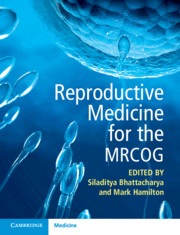Book contents
- Reproductive Medicine for the MRCOG
- Reproductive Medicine for the MRCOG
- Copyright page
- Contents
- Contributors
- Chapter 1 Epidemiology and Initial Assessment of the Infertile Patient
- Chapter 2 Disorders of Ovulation and Reproductive Endocrine Disorders Associated with Infertility
- Chapter 3 Endometriosis
- Chapter 4 Uterine and Tubal Causes of Infertility
- Chapter 5 Andrology and Infertility
- Chapter 6 Unexplained Infertility
- Chapter 7 Assisted Reproduction
- Chapter 8 Adjuvants in Assisted Reproduction
- Chapter 9 Laboratory Procedures for Assisted Reproduction
- Chapter 10 Fertility Preservation
- Chapter 11 Third-Party Reproduction
- Chapter 12 Managing Ethical Dilemmas in Reproductive Medicine
- Chapter 13 Evidence-Based Reproductive Medicine
- Chapter 14 The Organisation of Services and Quality Assurance in Fertility Practice
- Index
- References
Chapter 4 - Uterine and Tubal Causes of Infertility
Published online by Cambridge University Press: 25 February 2021
- Reproductive Medicine for the MRCOG
- Reproductive Medicine for the MRCOG
- Copyright page
- Contents
- Contributors
- Chapter 1 Epidemiology and Initial Assessment of the Infertile Patient
- Chapter 2 Disorders of Ovulation and Reproductive Endocrine Disorders Associated with Infertility
- Chapter 3 Endometriosis
- Chapter 4 Uterine and Tubal Causes of Infertility
- Chapter 5 Andrology and Infertility
- Chapter 6 Unexplained Infertility
- Chapter 7 Assisted Reproduction
- Chapter 8 Adjuvants in Assisted Reproduction
- Chapter 9 Laboratory Procedures for Assisted Reproduction
- Chapter 10 Fertility Preservation
- Chapter 11 Third-Party Reproduction
- Chapter 12 Managing Ethical Dilemmas in Reproductive Medicine
- Chapter 13 Evidence-Based Reproductive Medicine
- Chapter 14 The Organisation of Services and Quality Assurance in Fertility Practice
- Index
- References
Summary
Uterine and tubal abnormalities alone or in combination with other factors are present in 17%–25% of all couples who seek care for infertility treatment. The prevalence is higher in older women and in those with secondary infertility. Although suspected at the history, it is usually confirmed by ultrasound/ laparoscopy and/or MRI depending on the cause. Multiple pathologies are identified under the umbrella of tubal and uterine factors, some are associated with infertility but very few are proven to be the only cause of infertility. Treatment depends on the condition. It ranges from no intervention to surgery to in vitro fertilisation (IVF). With advances in the technology of IVF, surgery is becoming a lost art, especially for tubal factors. Various surgical techniques have been suggested for uterine factors. Given most tubal and uterine factors have association rather than causation for infertility, the effect of surgery on improving fertility is debatable. We will discuss the causes of uterine and tubal factors, their implications on fertility, diagnostic modalities and treatment options with limitations of the available evidence. A good history and a high index of suspicion along with primary and secondary prevention of tubal and uterine factor infertility are important to prevent long-term implications.
Keywords
- Type
- Chapter
- Information
- Reproductive Medicine for the MRCOG , pp. 31 - 42Publisher: Cambridge University PressPrint publication year: 2021



